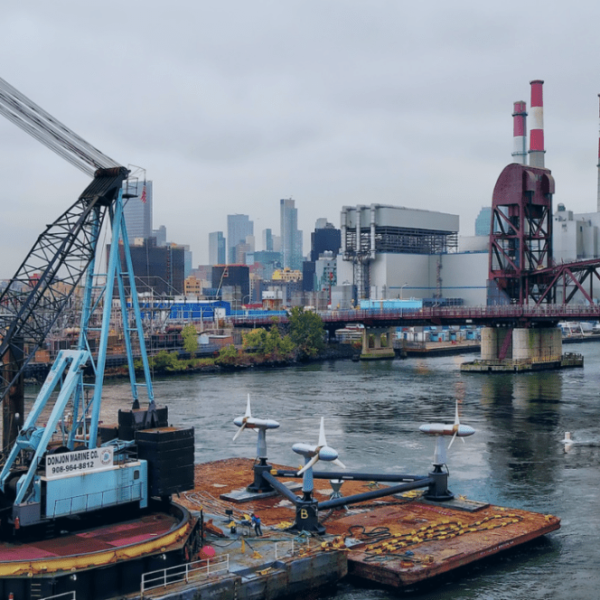Wave energy harnesses the motion of waves as a source of clean, affordable, and renewable power.
While wave energy technology can take many forms, one technology developer is undertaking a particularly innovative approach. Historically, companies involved in wave energy development have looked to place their technology offshore, but Eco Wave Power, founded in Israel in 2011, has found success with its unique floater system, which adapts to onshore and nearshore environments.
The floaters are hooked up to existing manmade structures, respond to the movement of the waves, and retract during stormy conditions, allowing for versatile installation while reducing potential damage caused by intense ocean weather.
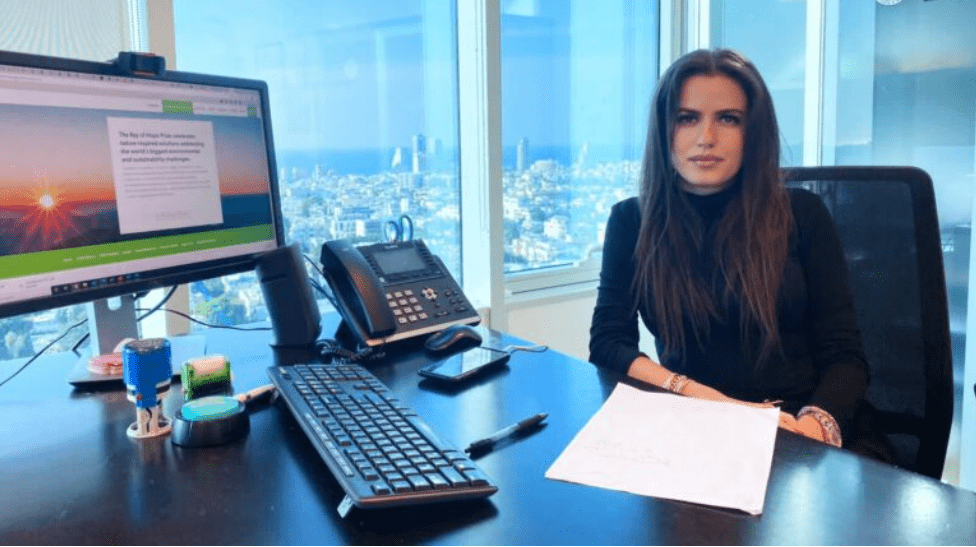
Inna Braverman, CEO of Eco Wave Power
The work of Eco Wave Power has been highlighted globally. The United Nations’ manager of its Global Climate Action program called the technology “a shining example of a scalable, effective climate solution.” Eco Wave Power received the United Nations’ Global Climate Action Award in 2019.
Eco Wave Power’s co-founder and CEO Inna Braverman has since taken the wave energy technology from its origins in Israel to locales around the world. With large-scale concession agreements signed in both Portugal and Spain, as well as a recent collaboration with AltaSea at the Port of Los Angeles to grid connect Eco Wave Power’s technology, the company has been flourishing.
Fueled by a deep connection to renewables and a desire for all people to have access to clean, affordable sources of energy, Inna Braverman spoke with the National Hydropower Association’s POWERHOUSE to share insight into the history of Eco Wave Power, the future of wave energy, and the opportunities in this sector.
POWERHOUSE: Discuss your background/history. How did you get involved with wave energy? What was the inspiration for Eco Wave Power?
Inna Braverman: It’s a very unique story. I live in Israel, but I was born in Ukraine in 1986, two weeks before the Chernobyl nuclear disaster. After the Chernobyl explosion, I was one of the babies hurt by the negative effects of the explosion. Luckily, my mother, a nurse, approached my crib in time and saw I was blue, not breathing, and gave me mouth-to-mouth resuscitation, which saved my life. As I was growing up, during all my family gatherings and meetups, I kept hearing about this story and how I got a second chance at life.
When I was four, my family emigrated to small town in northern Israel, Akko, where you don’t hear words like tech and startup, so I decided to study Political Science and English Literature at Haifa University, as I thought that, by going into politics, I could do something good for people with the second chance I received. However, when I finished my degree, there was no line of politicians waiting to hire a young lady with a degree in Political Science and English Literature, so I went to look for a job.
I started as an English-Hebrew translator for a renewable energy company, which is where I learned about the whole incredible sector of renewable energy, as well as wind energy, solar energy, and wave energy; however, whereas the wind and solar energy sectors were already almost fully commercialized, in the wave energy sector there was a lot of room for innovation.
According to the World Energy Council, wave energy has the potential to produce twice the amount of electricity than what is being produced now, but no one was making wave energy a reality. I knew I could make wave energy happen.
By using research databases, I started trying to understand why the tech used by other wave energy developers was too expensive and why it did not survive the marine environment, as well as what went wrong. I came up with my own concepts, but I didn’t have the money to build a power station or even register a patent.
One day, I went to a social event, and this guy, who had a hippie look, came and sat next to me, asking, “What is your passion?” His name is David Leb, and it turned out that he is a serial entrepreneur, who invested the proceeds of his business ventures into real estate, one property being a surf hotel in Panama, where he would watch the surfers and figured that there must be something else you can do with the energy of the ocean. In a completely different side of the world, he also started researching wave energy and came up with his own concept and ideas on how to make wave energy a reality.
So, when we met and it turned out that both of us are passionate about wave energy, it was like a match made in business heaven. He ended up investing the first $1 million [USD], and that was the beginning of Eco Wave Power, which has grown significantly since and is now traded on Nasdaq Capital Market with the stock symbol WAVE.
POWERHOUSE: Eco Wave Power’s floater technology is fascinating. Can you speak more about how the technology was developed? Walk us through the history of the product. Is the current design a finished product, or is Eco Wave Power still looking to refine the floater system? What would you change – or not change – for future developments?
Inna Braverman: The technology was first developed when I met David Leb, Eco Wave Power’s initial investor. We had our theoretical and conceptual ideas; however, we didn’t know if our ideas would work in practice. As a result, I went to Ukraine, as the engineering price there was less expensive than in Israel, and we made a competition with 300 engineers, as our goal was to choose a team of five, and we believed that they could assist us in turning our ideas and concepts into actual sketches and blueprints.
When we had a design, we rented a wave pool at the Hydro Mechanical Institute in in Kyiv in December of 2011. By the end of testing in the wave pool, we received an approval from the Israeli Ministry of Energy for the workability of the technology and a recommendation to test it in larger scale and in real marine conditions.
When we first tested in Ukraine, we could see that the tech really worked, and later we received permission from Jaffa Port in Israel to ship [the prototype] and test our very first wave energy pilot in Israel. Our real conditions off-grid testing took place between 2014-2020.
Also, we have almost finalized the construction of a second soon-to-be-grid-connected wave energy array in Israel. This is performed in collaboration and with co-investment from the Israeli Energy Ministry and EDF Renewables IL (a subsidiary of the French National electric company).
We also recently signed our first large-scale concession agreement in Port Adriano, Spain, and with Administração dos Portos do Douroin Portugal. Regarding the project in Spain, Eco Wave Power is planning to install a 2-MW wave energy project on the island of Mallorca. The installation will produce clean energy from waves to be used by Port Adriano, which is a modern marina and the base for many super yachts. The project’s construction time is expected to run between 18-24 months and will connect directly to the 500-meter breakwater at Port Adriano and to nearby substations at the port. According to the terms of the Concession Agreement, the 2-MW project is expected to operate for an initial 20 years at Port Adriano.
As to the planned project in Portugal, Eco Wave Power is planning to collaborate with Painhas, an engineering and construction firm, who will provide technical support for the planned wave energy project at the Port of Leixoes. In 2021, Eco Wave Power received an installation and grid connection permit of 1 MW, which is the first stage of the 20-MW Concession Agreement entered into with the Administração dos Portos do Douro.
We are always looking to upgrade and being able to overcome the biggest industry issues. We don’t stop, we keep upgrading our technology, which includes updates of the software and of the hardware of our design.
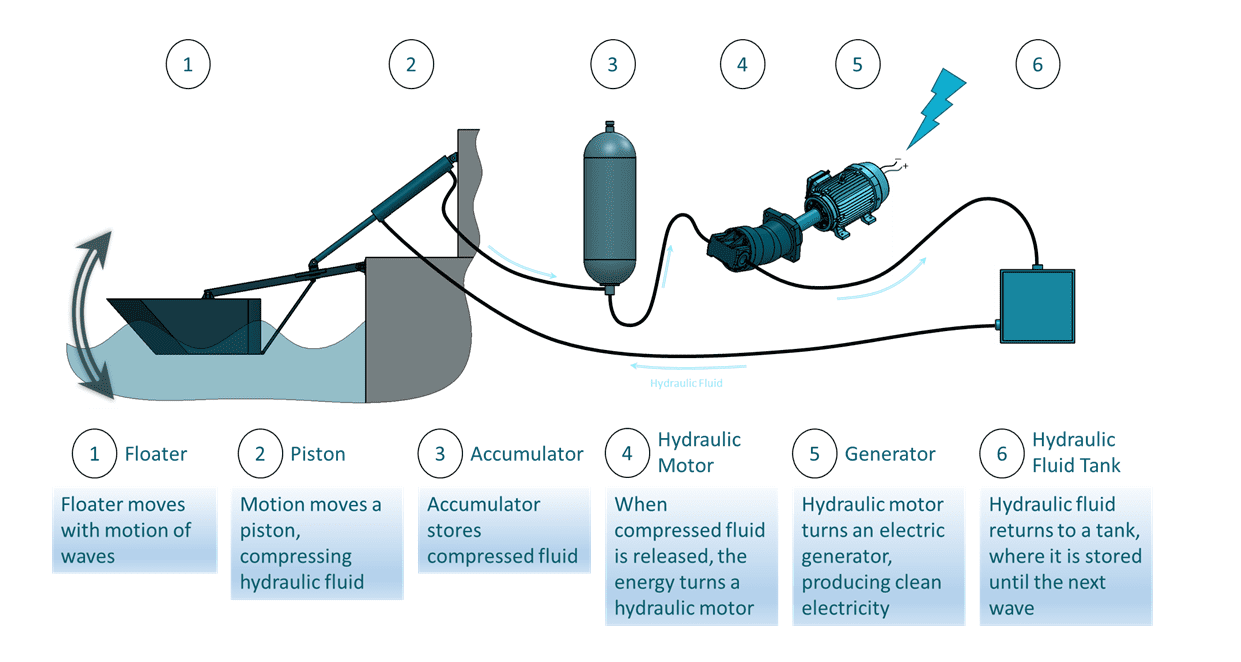
Breakdown of how Eco Wave Power’s floater system functions
POWERHOUSE: Eco Wave Power recently partnered with AltaSea at the Port of Los Angeles; can you speak more about how the partnerships began? What is Eco Wave hoping to accomplish with this partnership?
Inna Braverman: Discussions began with the Port of Los Angeles, as they own a large-scale breakwater, potentially suitable for a commercial-scale wave energy project, and they suggested that we commence the collaboration through a pilot installation in the port and in collaboration with AltaSea, an organization dedicated to finding rapid solutions for some of the planet’s most pressing challenges while functioning as an incubator for science, business, and education ventures looking to meet this shared goal.
=When the 100-kW pilot arrives to the site by autumn of 2022, it will be our first time connecting to the grid in the U.S. [via the Port of Los Angeles], so we’ll start there, and then we aspire to expand to the whole breakwater surrounding the Port of Los Angeles, as well as other locations and states.
The conversion unit and one floater system will arrive in September from the Gibraltar site, and then more floaters will be manufactured in the United States, which will generate construction jobs in Los Angeles.
The first floater system will be installed as soon as all licenses are in place , and Eco Wave Power will invite visitors to the AltaSea campus with the opportunity to learn more about wave energy. As additional floater systems are produced, they will be installed at AltaSea’s premises in the Port of Los Angeles.
The U.S. market is a huge market, and according to the U.S. Energy Information Administration, wave energy can produce 66% of U.S. energy needs. We are keen on this partnership [with AltaSea], and it is an exciting opportunity.
Right now, we are re-locating the power station’s conversion units, which will be fully overhauled and refurbished to meet the U.S. electrical standards. The shipping will be made from Gibraltar, a British territory bordering Spain, where the power station was operational and grid connected for almost six years.
In 2014, we signed a 5-MW Power Purchase Agreement with the Government of Gibraltar and the Gibraltar Electricity Authority, and upon the expansion of the project to 5 MW, Eco Wave Power could supply 15% of the country’s energy needs.
The 100 KW pilot in Gibraltar was co-funded by the European Union Regional Development Fund, as well as private groups, the wave energy power station opened in May of 2016. Gibraltar represented our first grid-connected project and a significant step towards the commercialization of our technology.
With over six years of operational service in Gibraltar, and 49,632 grid-connected hours at the pilot site, Eco Wave Power was able to reach 73% of the forecasted available energy for the site in 2020, which is an improvement compared to the 30% seen in the same period during 2017-2018. The maintenance costs at Gibraltar also decreased from 18% in 2017 to 3.2% in 2021.
We have already dismantled everything that needs to be dismantled, and in the next few months we’ll be ready, pending any issues with licensing and grid connection approvals at AltaSea’s campus, a 400,000 square foot site built on a historic pier at the Port of Los Angeles, featuring 4,100 feet of linear dock space.
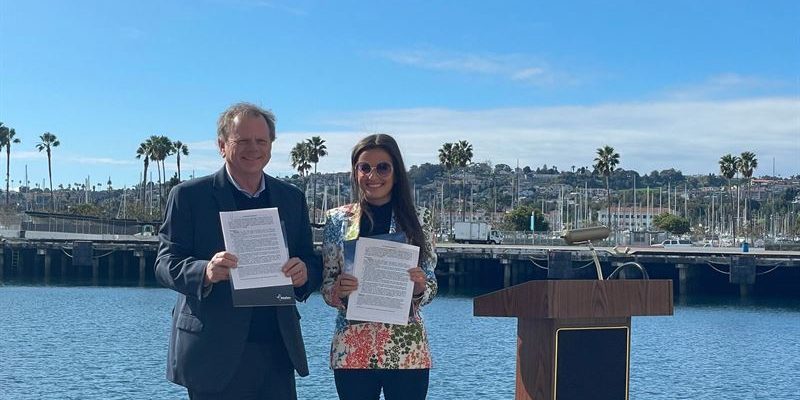
Inna Braverman, CEO of Eco Wave Power, and Terry Tamminen, CEO of AltaSea, holding signed Collaboration Agreements at the Port of Los Angeles in January 2022
POWERHOUSE: With Eco Wave Power recently listed on Nasdaq U.S., can you speak to Eco Wave Power’s goals/ambitions in the United States? How can Eco Wave’s technology serve the U.S.’s renewable energy goals?
Inna Braverman: First off, according to President Biden, he wants the U.S. to go net zero by 2050. It’s important to look at the renewable energy sector, as it currently provides only a small amount – 18 percent – of global electricity.
Wave energy is a really large source of renewable energy, and it contains a lot more power potential than wind, as water has 832 times the density of air. Also, in suitable locations, wave energy can operate around the clock; solar and wind are great, but you have to add more to really go net zero like the U.S. wants to achieve.
Like I said, wave energy is capable of providing 66% of the U.S.’s energy needs, but in order to make it happen, legislation has to be in place. As a result, we are collaborating on a legislative path, working with New Jersey Assemblyman Robert Karabinchak; his goal is to promote new legislation to add wave energy to New Jersey’s Energy Master Plan. According to the best of my knowledge, this will make New Jersey the first U.S state to legislate for wave energy.
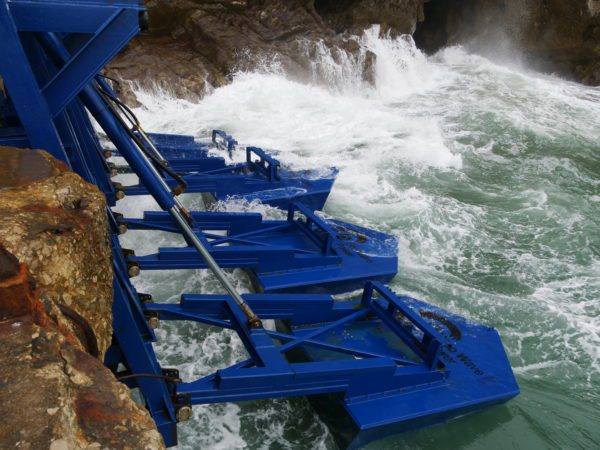
Eco Wave Power’s floater system in action
POWERHOUSE: POWERHOUSE, the National Hydropower Association’s online platform, is read by hydro operators, government agencies, and others involved in the renewables space. What do you want to convey to this audience? What is your message to these readers?
Inna Braverman: Basically, I would like the readers to be aware that wave energy exists and that it is a great renewable energy resource, which can provide TWICE the amount of electricity that the world produces now. To be more specific, from government agencies, I would like to see more legislation and more policy to support it [wave energy], like wind and solar have received.
The world doesn’t have the luxury to sit around and wait anymore. To hydro operators, and others involved in the renewables space, I would say “join us in changing the world one wave at a time!” Wave energy is new and exciting, and there is a lot of room for strategic partnerships with experienced developers.
POWERHOUSE: Reading through Eco Wave Power’s press mentions and news stories, the company has an international focus. Can you speak to how you view Eco Wave Power’s tech as a force for change in the global sector? What do you envision as the future for the company in the next 10 years? The next 20 years?
Inna Braverman: I believe that Eco Wave Power can make a significant change in the global renewable energy sector with the first technology to prove wave energy can become commercially viable. In the past, other companies have decided to go offshore, but in doing so they have encountered problems like high costs, tricky installations on the ocean floor, and the overall difficulty that comes with designing equipment that withstands stormy conditions, and all of that is before having the chance to connect to the grid.
In 2011, when we established Eco Wave Power, and I was presenting our unique wave energy technology, people had either never heard of it, or they have heard that it is too expensive and breaks down all the time. However, by creating a technology that is on-shore and near-shore (attached to existing marine structures such as piers, breakwaters, jetties etc.), we were able to avoid the issues previously mentioned.
Our first grid-connected wave energy array was built in Gibraltar in 2016, and the cost was only $450,000 (USD), as opposed to the millions of dollars spent on offshore wave energy technologies – this was the real scientific breakthrough.
Also, by attaching to existing marine structures, our equipment did not have to be exposed to wave heights of 20 meters, and in the case of stormy conditions, we came up with a patented storm protection mechanism; basically, when the waves are too high for the system to handle, the floaters automatically rise above the water level and stay in the upward position until the storm passes.
Due to our low costs and high reliability, we are insurable by large-scale insurance companies. We also have the support of the environmentalists, as we do not connect to the ocean floor; instead, we only connect to pre-existing, man-made marine structures, which are not prime real estate and were not used for anything other than breaking the waves.
What I envision for the future involves incorporating wave energy arrays in breakwaters everywhere in the world. They [breakwaters] are there to protect the ports and coastal populations from stormy conditions, but they are not environmentally friendly. In my vision, why not take these marine structures and turn them into a clean energy source? Why not incorporate wave energy there? Take it one step further and incorporate wave energy into the breakwater design at the beginning stages; instead of making tech to fit it, let’s build it [breakwaters] so it incorporates the technology.
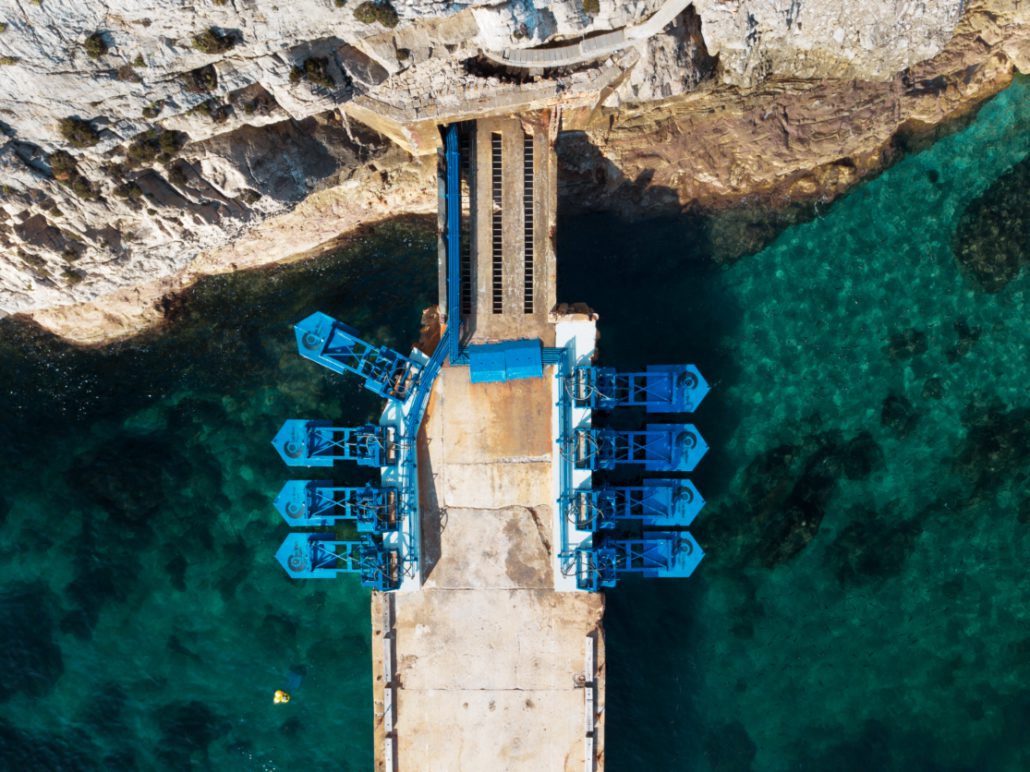
Eco Wave Power’s floater system – photo taken from above in Gibraltar
POWERHOUSE: What do you view as the biggest challenges facing renewables like wave energy? How can we, as a society, overcome those challenges?
Inna Braverman: The No. 1 challenge is a lack of policy and legal frameworks in many countries, which is something that needs to change because without proper legal frameworks it is impossible to construct anything. However, I am optimistic in this regard because solar and wind started the same way as wave energy. When the first person came along and wanted to build the first solar farm in Israel, there was no precedent. However, now everything is different, and solar energy has proper support and legislation.
The second thing, and this is a shared problem with commercialization of all innovative technologies, is that the easiest way to build multiple power stations is to access debt financing. Because wave energy is a very new renewable energy source, it is not possible to secure debt financing. As a result, our only way to secure funding for the construction of our power stations is through equity, which is the most expensive form of financing, or through grants, which are not always available. So, it creates a situation where we are slowed down.
If we could get the project pipeline moving, we have 327.7 megawatts of projects in our pipeline, but we are only able to build the power stations one by one, so if we could get access to debt financing, then it could be easier to build more.
POWERHOUSE: According to Eco Wave Power’s website, one of the stated goals is “Eco Wave Power aspires to build wave energy power stations which shall give people access to electricity in proximity to their residence without creating air pollution.” How do you see this happening? What steps need to occur in order to make this a reality?
Inna Braverman: Right now, two thirds of the world’s population live within 200 km of the coastline; therefore, the need for wave energy is undeniable. You can imagine how much money and transmission costs could be saved if we could power houses on the coastline directly with wave energy.
As I’ve already said, we need proper legislation and support just like wind and solar have received in order to make a commercial roll-out possible.
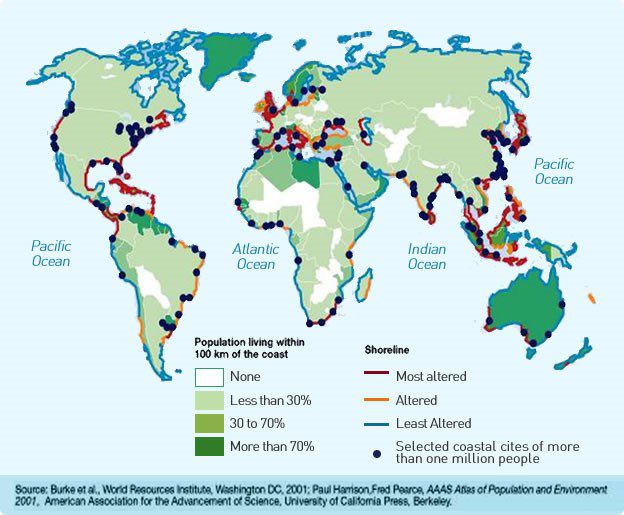
Map showing human population centers near shorelines
POWERHOUSE: Overall, realizing Eco Wave Power’s technology and achievements, what stands out as the greatest technical challenge(s) and accomplishments?
Inna Braverman: The technical challenges are obvious, and they consist of the corrosive environment of the ocean and stormy conditions, which we have overcome with our designs.
We hope to become the first company to build the first commercial-scale wave energy project in the world. Once we open our commercial scale, it will be a big step forward.
Our aspiration is to show that wave energy can produce large amounts of electricity and be profitable, which will be a big step forward for the wave energy sector as a whole.








